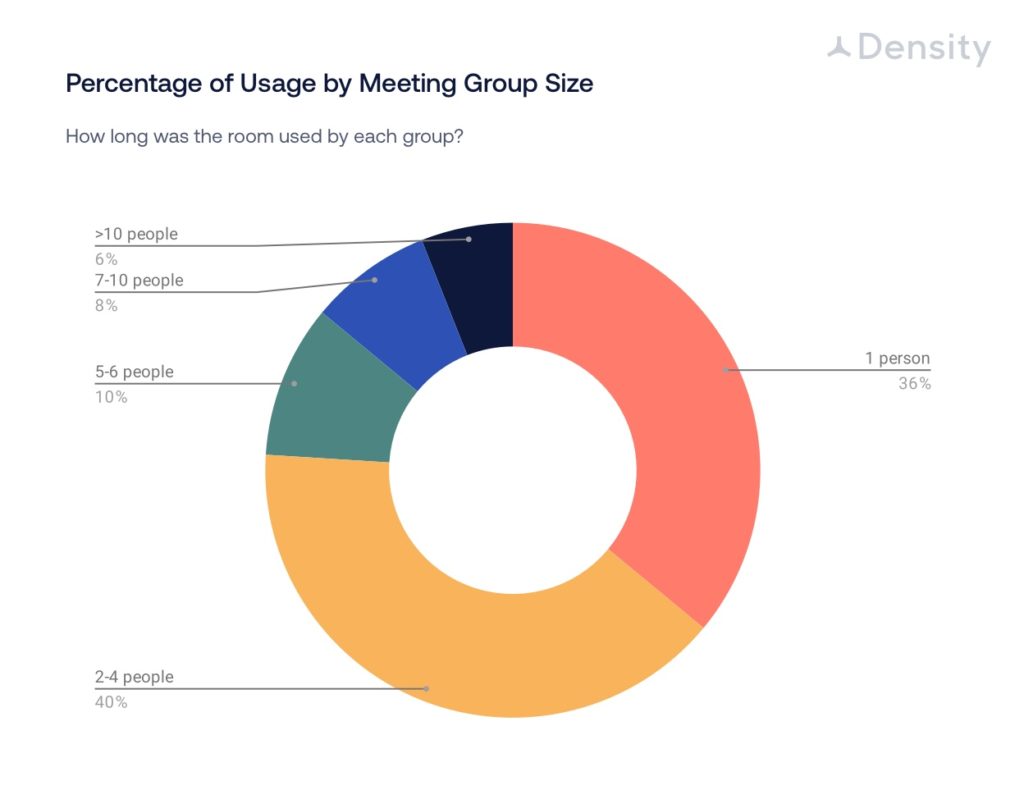In the post-pandemic workplace, workplace teams and employees alike need to strike the right balance between conducting “business-as-usual” and continuing to leverage mitigation tactics such as social distancing. We can no longer assume people feel comfortable being in close quarters with others.
Conference rooms pose a specific risk to social distancing. They are designed to enclose groups of people in a fixed space for extended periods of time. Using Density data and feedback from customers, we set to address key considerations around post-pandemic conference room use and social distancing:
- Are conference rooms used in a way that poses risks to social distancing?
- If so, what can workplace teams do to mitigate these risks?
- How can workplace teams tell if these mitigations are effective?
Do conference rooms pose a risk to social distancing?
Yes, although not as often as you’d think. In our 2019 Workplace Utilization Index, Density analyzed more than 10,000 hours of meetings over 6 months across 60 conference rooms. The data yielded insights as to ways in which conference room usage may or may not pose risks to social distancing.

- Conference rooms are often occupied by only 1 person — 36% of the time
- 85% of meetings had fewer than 7 attendees
- 6% of meetings had 10 or more attendees
- 2-4 person rooms were 2x as likely to be at overcapacity as 5 -person rooms.
This is important information. 36% of the time, conference rooms are used in a way that does not pose a risk to social distancing. Smaller meetings are far more common than larger meetings, suggesting an opportunity for smaller meetings to upsize to conference rooms without crowding out larger meetings. Smaller conference rooms (2 to 4 person rooms) are the likeliest to be at or over capacity, meaning they should be prioritized for social-distancing mitigation efforts.
How can workplace teams encourage social distancing in conference rooms?
Any given conference room poses a risk to social distancing by gathering a group of people in an enclosed space for the duration of the meeting. To counteract this, the solution is straightforward: let fewer people in so there’s more flexibility to maintain social distancing.
Workplace teams can execute this by setting capacity limits that are lower than current capacity limits on all conference rooms.
On average, the minimum size of a 4-6 person conference room containing a 4’x6′ table is 168 square feet. The CDC recommends that employees “maintain 6 feet and practice social distancing as work duties permit.” This translates into a 28 square-foot (i.e. a circular area with a 3-foot radius surrounding each person) allotment per person. Doubling this allotment to approximately 60 square feet to account for variable room configurations implies a recommended capacity of 2-3 people for this 4-6 person conference room, or a capacity reduction of approximately 50%.

This is a generalized example. Workplace teams should customize COVID-19 capacity limits based on the size and layouts of each of their conference rooms.
However, further limiting capacity across the board could lead to a dearth of appropriately-sized conference rooms. As noted in our workplace index, the frequency of smaller meetings relative to larger meetings indicates that there is ample opportunity for smaller groups to take advantage of larger rooms without impacting larger group meetings that inherently need more space.
For situations where a company cannot afford to give up larger spaces for smaller meetings, workplace teams need not fret. COVID-related WFH mandates have pushed employees and managers to adopt greater familiarity with conducting remote meetings. Ideally, employees will appreciate these enhanced safety efforts and forgive the novelty of remote conferencing, albeit inconvenient at times.
How can workplace teams tell if occupancy limits are effective?
Density customers can use a variety of reporting methods on their people-count and conference room-usage data to help evaluate the impact of capacity limits on conference rooms. They also can use this data to manage conference room allocation going forward.
Density provides detailed reporting on per-conference room usage, including:
- Utilization Against Present Capacity Limits
- Hourly Occupancy Heatmaps and Time Series reports
- Meeting Bookings vs. Attendance
Managing the post-pandemic return to work is challenged by the risk and uncertainties for workplace teams and employees alike. Person-to-person proximity is a particular challenge inherent to conference rooms. Density customers are well-equipped to leverage their people-count data to identify which conference rooms are most likely to pose a risk to social distancing and to develop and test data-driven solutions to mitigate these risks.
Ultimately, the value of this data will be in providing continuous feedback on how effectively these solutions are working. Take a deeper dive into planning with our guide: How to plan for social distancing in the workplace.
